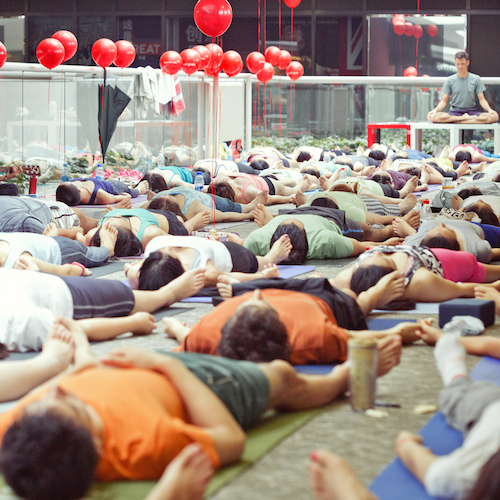Savasana may be translated as Corpse Pose, but are we really supposed to play dead?
We do Savasana in just about every yoga class, but it is one of those poses like Downward Facing Dog that generally gets very little attention or instruction.
What are we supposed to do during Savasana? What is it exactly? What is the point of just lying there?
“Lying upon one’s back on the ground at full length like a corpse is called Savasana. This removes the fatigue caused by the other asanas and induces calmness of mind.” ~ Hatha Yoga Pradipika, V.32, C.1
Savasana is really the whole point of yoga class.
All of the other poses, all of the sweating and hard work lead up to Savasana. We do everything else so that when it comes time for Savasana we are ready to relax, are able to lay there without moving, and are better able to practice the yoga of spending time with a calm mind.
B.K.S. Iyengar wrote in Light On Yoga, “Conscious relaxation invigorates and refreshes both body and mind. But it is much harder to keep the mind than the body still. Therefore, this apparently easy posture is one of the most difficult to master…The stresses of modern civilisation are a strain on the nerves for which Savasana is the best antidote.”
In other words, Savasana is kind of important.
It shouldn’t be an afterthought to our practice and we shouldn’t short-change our practice by skimping on Savasana.
Some teachers talk us into this final pose by offering adjustments, but just as often they’ll say nothing apart from, “Relax, you earned it.”
When I hear that in class, I check my basic alignment, then turn to my seven tips for savoring Savasana.
The basic alignment check-list for Savasana I follow is:
• Lie down on my back
• Tuck my shoulders underneath me
• Rest my arms at roughly a 30° angle from my torso with my palms facing up
• Straighten my legs and bring them almost mat-width apart
• Relax my legs, letting my feet roll out and be light
Once I’ve done all of that, I can finally start to relax. I know, easier said that done, right?
When I’m having trouble relaxing, these seven tips help me get the most from Savasana:
1. Stretch it out. Before relaxing completely, I take a deep long inhale and stretch my entire body from my heels to the crown of my head. I even stretch out through my fingers, too. With my exhale I relax completely, settling into Savasana.
2. Take it slowly. It can be difficult to fully relax after working hard in yoga class. I take several breaths to slowly allow my breath time to soften and return to a normal, smooth, light breathing. This calms my nervous system and mind so I can relax.
3. Mentally scan my body. After firing up my body in yoga, I’m most likely holding tension somewhere. So I do a quick scan for any tight places and, with my mind, focus on the area and ask it to relax. I make sure to relax my toes, the soles of my feet, and my ankles. Then I relax my fingers, wrists and elbows.
4. Relax muscles in my head. Relaxing my jaw allows my tongue to float in my mouth. It’s easy to hold tension in our tongue and jaw without noticing. Then I soften at the roots of my eyes too, so my eyes feel heavy.
5. Let go of any thoughts. Like in meditation, it can be hard to relax and think of nothing in Savasana. When I notice I am thinking about something, I don’t get mad at myself—I just let it go and return to a restful state. In Savasana, I often find myself lost in the middle of a complex thought, not realizing it had even started. When I notice, that is when I am able to pause, stop the chatter, and relax again.
6. Support my neck. I injured the disc between my C5 and C6 vertebrae in a non-yoga accident a few years ago, so my neck hurts in Savasana if I don’t support it. A folded blanket or a meditation cushion is enough to lift my head so that my forehead is a bit higher than my sternum (breast bone). (A full size block is too high for most people.)
7. Don’t fall asleep. Savasana is not sleeping. It is playing the edge between conscious and unconscious. If you fall asleep, it’s not Savasana anymore, it’s a nap. We have all fallen asleep in Savasana at least once but part of the challenge of the pose is to stay awake while relaxing completely.
After every practice I try to spend at least five minutes resting in Savasana. Personally I like a 5-7 minute Savasana for 60-90 minutes of asana and if it’s a 2+ hour class or workshop, I like to give students at least 10 minutes.
After a fun practice, I feel I have earned a good Savasana. By following these tips it has become a blessing to be in Savasana, transforming it into the part of class I can’t wait for, not the pose I want to skip.
When it comes to music, I like a silent Savasana, but if you’re looking for tips on music you might like in Savasana check out the less traditional recommendations offered below.
~
Relephant Read:
My 5 Favorite “Non-Traditional” Savasana Songs.
~
Author: Stephen Ewashkiw
Editor: Renee Jahnke
Image: Used with permission of photographer Zhou Zihan
~



Read 1 comment and reply